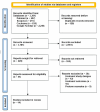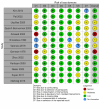Impact of Antenatal Corticosteroids on Cortisol and Glucose Homeostasis Levels in Preterm Neonates: A Meta-Analysis
- PMID: 39735060
- PMCID: PMC11682728
- DOI: 10.7759/cureus.74763
Impact of Antenatal Corticosteroids on Cortisol and Glucose Homeostasis Levels in Preterm Neonates: A Meta-Analysis
Abstract
Antenatal corticosteroids (ACS) are widely used to reduce respiratory distress syndrome (RDS) in preterm neonates, enhancing neonatal outcomes. However, the potential effects of ACS on other aspects of neonatal health, such as cortisol levels and glucose regulation, remain a concern. This study examines whether ACS administration impacts cortisol and glucose homeostasis in preterm infants by analyzing data from 14 selected studies. Using a random-effects model, we found no significant impact of ACS on cortisol levels (mean differences (MD) 2.23, confidence interval (CI) 5.26 to -0.80) or blood glucose levels (standard mean differences (SMD) 0.18, CI 0.00 to 0.35). Additionally, there was no notable difference in hypoglycemia risk between groups receiving ACS and those unexposed (odds ratio (OR) 1.46, CI 0.99 to 2.17). Subgroup and sensitivity analyses reinforced these findings, underscoring their robustness, and risk-of-bias assessment confirmed a low risk across the included studies. Our findings support the safety of ACS for cortisol and glucose levels in preterm infants, affirming its continued use for lung development while recommending vigilant blood glucose monitoring to manage potential hypoglycemia. These results provide essential insights for neonatal care protocols, contributing to the overall welfare of premature infants.
Keywords: antenatal corticosteroids; blood-glucose; cortisol; hypoglycemia risk; preterm neonate.
Copyright © 2024, Bharadwaj et al.
Conflict of interest statement
Conflicts of interest: In compliance with the ICMJE uniform disclosure form, all authors declare the following: Payment/services info: All authors have declared that no financial support was received from any organization for the submitted work. Financial relationships: All authors have declared that they have no financial relationships at present or within the previous three years with any organizations that might have an interest in the submitted work. Other relationships: All authors have declared that there are no other relationships or activities that could appear to have influenced the submitted work.
Figures















Similar articles
-
Antenatal corticosteroids for accelerating fetal lung maturation for women at risk of preterm birth.Cochrane Database Syst Rev. 2020 Dec 25;12(12):CD004454. doi: 10.1002/14651858.CD004454.pub4. Cochrane Database Syst Rev. 2020. PMID: 33368142 Free PMC article.
-
Antenatal corticosteroid therapy, delivery intervals and perinatal mortality in low-resource settings.J Trop Pediatr. 2023 Oct 5;69(6):fmad037. doi: 10.1093/tropej/fmad037. J Trop Pediatr. 2023. PMID: 37991049
-
Time interval from late preterm antenatal corticosteroid administration to delivery and the impact on neonatal outcomes.Am J Obstet Gynecol MFM. 2021 Sep;3(5):100426. doi: 10.1016/j.ajogmf.2021.100426. Epub 2021 Jun 18. Am J Obstet Gynecol MFM. 2021. PMID: 34153514
-
Antenatal corticosteroids and outcomes of preterm small-for-gestational-age neonates in a single medical center.Obstet Gynecol Sci. 2018 Jan;61(1):7-13. doi: 10.5468/ogs.2018.61.1.7. Epub 2017 Dec 26. Obstet Gynecol Sci. 2018. PMID: 29372144 Free PMC article.
-
Strategies for optimising antenatal corticosteroid administration for women with anticipated preterm birth.Cochrane Database Syst Rev. 2020 May 26;5(5):CD013633. doi: 10.1002/14651858.CD013633. Cochrane Database Syst Rev. 2020. PMID: 32452555 Free PMC article.
References
Publication types
LinkOut - more resources
Full Text Sources
